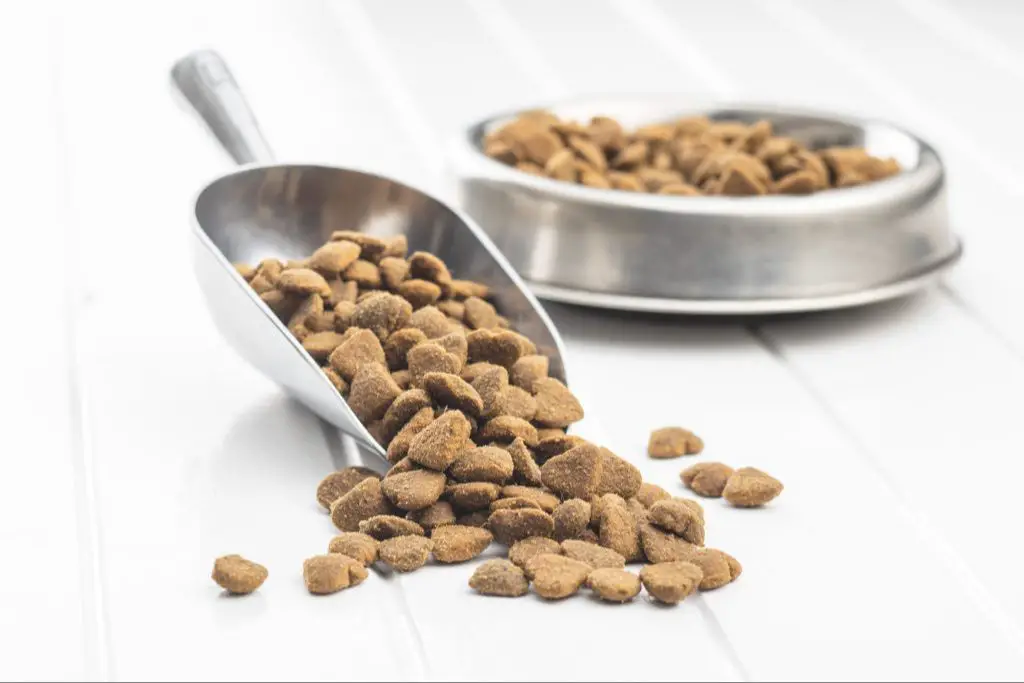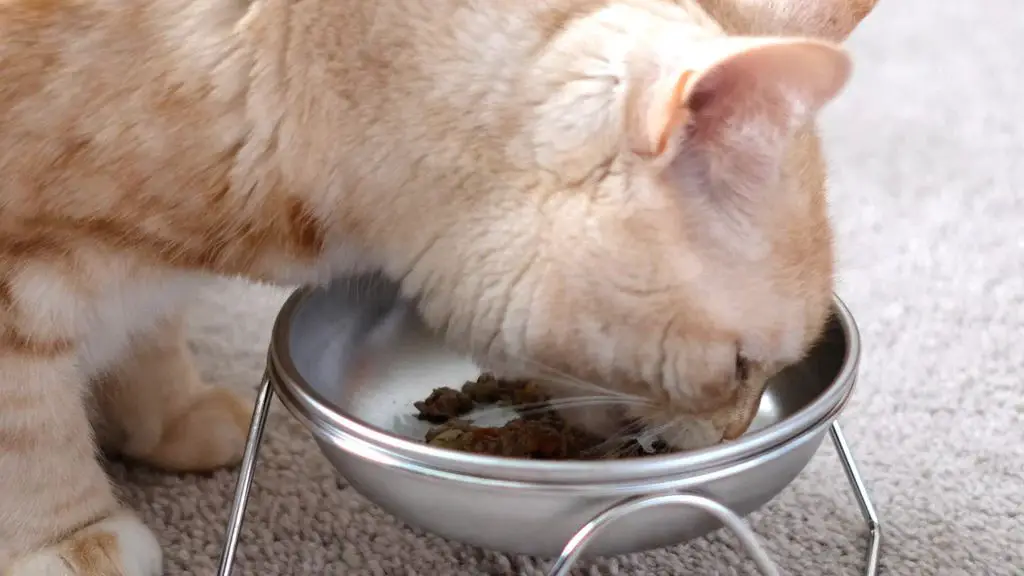Can Dogs Eat Cat Food?
Dogs can occasionally eat cat food without serious problems if they eat only a small amount. However, dogs cannot subsist on a diet of cat food alone because cat food does not have all of the nutrients dogs require for long-term health. Cat food is much higher in protein and fat than dog food and contains lacking nutrients like taurine. While the higher protein and fat content may seem appealing, too much can cause weight gain and other problems for dogs over time. Occasional nibbles of cat food are unlikely to cause harm, but cat food should not make up the bulk of any dog’s diet.
The most significant difference between cat food and dog food is the protein and fat content. Cat food is packed with more animal-based proteins and fats since cats are obligate carnivores and need higher amounts to thrive. According to the AKC, cat food contains about 40% protein and 20% fat, while dog foods contain around 25% protein and 15% fat.
Cat foods also have more taurine, arachidonic acid, and vitamin A – nutrients that are essential for cats but only needed in small amounts for dogs. On the flip side, some nutrients like vitamin D are added to dog food but not cat food. The nutrient balance tailored for each species means subsisting on the wrong food can lead to deficiencies over time.
Nutritional Differences Between Dog and Cat Food
Dog and cat foods are formulated to meet the specific nutritional needs of each species, which are quite different. As carnivores, cats have a higher requirement for protein than dogs.
Cat food contains about 45-55% protein, whereas dog food contains around 20-30% protein (https://www.meowmix.com/cat-care/difference-between-dog-and-cat-food). Cat food protein sources are usually animal-based like chicken, fish, and meat meals. Dog foods contain more plant-based proteins like peas, legumes and potatoes.

The higher protein in cat food helps support their high metabolic rate. But too much protein can be hard on dogs’ kidneys over time (https://www.pawcbd.com/blogs/posts/cat-food-vs-dog-food-how-they-are-different). Dogs also have lower requirements for certain amino acids like taurine.
In addition, dog food contains more calcium, fiber and carbohydrates compared to cat food formulas. The extra carbs give dogs an energy source for their active lifestyles. Cat foods are very low carb since cats get energy from protein and fat (https://www.petfoodinstitute.org/blog/cats-vs-dogs-5-differences-nutritional-needs/).
Dangers of Dogs Eating Cat Food
There are several health risks associated with dogs eating cat food, primarily related to the nutritional differences between cat and dog food formulas. Some of the key dangers include:
Weight gain – Cat foods contain up to 50% more fat and protein than dog foods. The higher fat content can quickly lead to weight gain or obesity in dogs, increasing the risk of related health issues like heart disease and arthritis. According to the AKC, dogs fed a cat food diet are prone to obesity even when fed the same amount as dogs eating dog food [1].
Pancreatitis – The high fat content in cat food is also linked to pancreatitis, a serious and potentially fatal inflammation of the pancreas. Fat triggers the release of pancreatic enzymes which then digest the pancreas itself. Dogs with pancreatitis require intensive veterinary treatment and must be transitioned to a special low-fat diet [2].
Kidney problems – Cat foods contain nearly 2 times more protein than dog food. Excess protein puts a strain on the kidneys as the body tries to eliminate the waste products. Over time this can lead to kidney disease, a common and serious condition in older dogs [3].
Nutrient deficiencies – Dog foods are formulated with a dog’s nutritional needs in mind. Cat foods lack adequate vitamins, minerals, and amino acids that dogs require. Deficiencies over time can cause a range of health issues in dogs.
Benefits of Dog Food for Dogs
Dog food formulated specifically for canines provides balanced nutrition tailored to their dietary needs. Unlike cat food, dog food contains optimal levels of protein, fat, vitamins and minerals to support your dog’s health and activity level [1].
High-quality dog food is designed to promote healthy skin and a shiny coat. The right balance of fatty acids supports skin integrity and minimizes shedding. Dog food also contains nutrients like glucosamine and chondroitin to keep joints supple and prevent arthritis [2].
With so many breeds and life stages to account for, dog foods are specially formulated for puppies, adults, seniors, small breeds and large breeds. This allows each dog to get nutrients tailored to their specific needs for optimal health and vitality [3].
When Cat Food May Be Okay for Dogs
There are some rare cases where it may be alright for dogs to eat cat food for a very short period of time or in an emergency situation:
If you unexpectedly run out of dog food, it’s okay to feed your dog cat food in the interim until you can get more dog food. However, this should only be for 1-2 meals at most (source).

When traveling or evacuating an area with your dog and cat, you may only have access to cat food. It’s understandable to feed your dog this temporarily until you can get proper dog food (source).
Some veterinarians may recommend a temporary switch to cat food if your dog has certain digestive issues or needs a very low-protein diet. Check with your vet before making any changes (source).
If you do need to feed cat food to your dog, choose a high-quality, grain-free option with lower protein content. Mix the cat food with your dog’s regular food to dilute the extra protein and nutrients (source). Only do this temporarily until you can transition back to regular dog food.
Signs Your Dog Is Sick from Cat Food
Some common signs your dog may be sick from eating cat food include:
Vomiting, diarrhea, gas – Cat food is higher in protein and fat than dog food. Too much can upset your dog’s stomach, causing vomiting, diarrhea, and gassy symptoms like flatulence (https://bottletreeanimalhospital.com/blog/dog-eats-cat-food/).
Weight gain – The increased calories in cat food compared to dog food can quickly lead to weight gain, especially in small dogs (https://www.akc.org/expert-advice/nutrition/can-dogs-eat-cat-food/).
Excessive thirst/urination – Cat food has more protein than dog food. Too much protein taxes the kidneys, causing increased thirst and urination (https://pethelpful.com/dogs/Dog-Eating-Cat-Food-Side-Effects-and-Risks).
Pancreatitis symptoms – The high fat content of cat food can inflame the pancreas. Symptoms include vomiting, diarrhea, lethargy, loss of appetite, and abdominal pain (https://www.akc.org/expert-advice/nutrition/can-dogs-eat-cat-food/).
Transitioning Your Dog Back to Dog Food
If your dog has been eating cat food, especially for an extended period, you’ll need to slowly transition their diet back to dog food. Abruptly switching their food can upset their stomach and cause digestive issues like vomiting or diarrhea. Here are some tips for safely transitioning your dog back to dog food:
Slowly mix increasing amounts of the new dog food into the cat food over 5-7 days. Start with a 75% old food/25% new food ratio, and gradually decrease the amount of cat food while increasing the dog food. Chewy recommends taking a full week to complete the transition.
Use bland foods like boiled chicken and rice initially to help their stomach adjust. Then slowly add in the new dog food. Probiotics can also help support their digestive system.
Stick to scheduled mealtimes instead of free-feeding. This gives their stomach time to fully digest one meal before the next.
Make sure they have plenty of fresh water available to stay hydrated.
Monitor their stool and energy levels. Signs of an upset stomach like diarrhea, vomiting, or lethargy may mean you need to transition more slowly.
Be patient – the transition may take a few weeks for some dogs. Follow veterinarian recommendations for transition timelines, especially for puppies or dogs with sensitive stomachs. With some dogs, the switch can take up to 40 days.
When to See the Vet
In most cases, dogs will recover on their own after eating cat food, especially if it was a one-time occurrence. However, it’s important to monitor your dog for any concerning symptoms and seek veterinary care if they persist or worsen.
Signs that warrant a trip to the vet include:
- Persistent vomiting and diarrhea
- Lethargy or weakness
- Loss of appetite
- Dehydration

These can be signs of serious conditions like pancreatitis, kidney problems, or gastrointestinal distress caused by the cat food. According to the AKC, some dogs can experience an inflammatory response to the higher protein and fat content in cat food [1]. Small dogs especially may struggle to process the higher calorie density.
In addition to the symptoms above, watch for these specific signs of pancreatitis:
- Abdominal pain
- Hunched back
- Excessive drooling
- Loss of appetite
Pancreatitis can occur if a dog eats a large amount of cat food, especially if they are not used to food with higher fat content. Seek emergency veterinary care if you suspect pancreatitis.
While one instance of a dog eating cat food likely won’t cause long-term issues, the veterinarian can advise on any steps needed to get your dog healthy again and prevent future cat food indiscretions.
Tips to Keep Your Dog Out of the Cat Food
One of the best ways to prevent your dog from eating your cat’s food is to keep the food separate and inaccessible to your dog. Here are some tips:
Feed cats separately, ideally in a different room than the dog. Close the door and don’t allow your dog access while your cat is eating. You can also try feeding your cat on an elevated surface like a cat tree, windowsill, or counter top. Dogs will have a harder time accessing the food up high (Petzyo).

Securely store any leftover cat food immediately after your cat finishes eating. Use containers with locking lids to prevent your dog from getting into the bag or can of cat food. Store containers in cabinets, on high shelves, or even in the refrigerator.
Distract your dog with a chew toy or treat when it’s time to feed your cat. Give them something positive to focus on instead of the cat food. Alternatively, place your dog in another room or crate them while your cat eats.
With a little planning and training, you can keep your dog out of the cat food. Feeding them separately and restricting access is key.
The Bottom Line
While the occasional nibble of cat food is low risk for dogs, extended feeding of cat food can lead to nutritional problems. Cat food is formulated to meet the unique nutritional needs of cats, which differ from the needs of dogs.
Specifically, cat food is higher in protein and fat, but lower in carbohydrates. It also contains higher levels of some key nutrients like taurine. While not immediately toxic, these differences mean cat food is not nutritionally balanced for dogs over the long term.
Feeding a dog cat food can potentially lead to issues like obesity, pancreatitis, and other gastrointestinal problems due to the high fat and protein content. As obligate carnivores, cats have a higher tolerance for excess protein and fat than dogs.
For optimal health, it’s best to feed dogs a complete and balanced dog food formulated to meet their specific nutritional needs. Keep your dog’s food separated from your cat’s food to prevent accidental eating. If your dog does get into the cat food occasionally, monitor them for any symptoms of illness and consider transitioning them back to dog food gradually.

